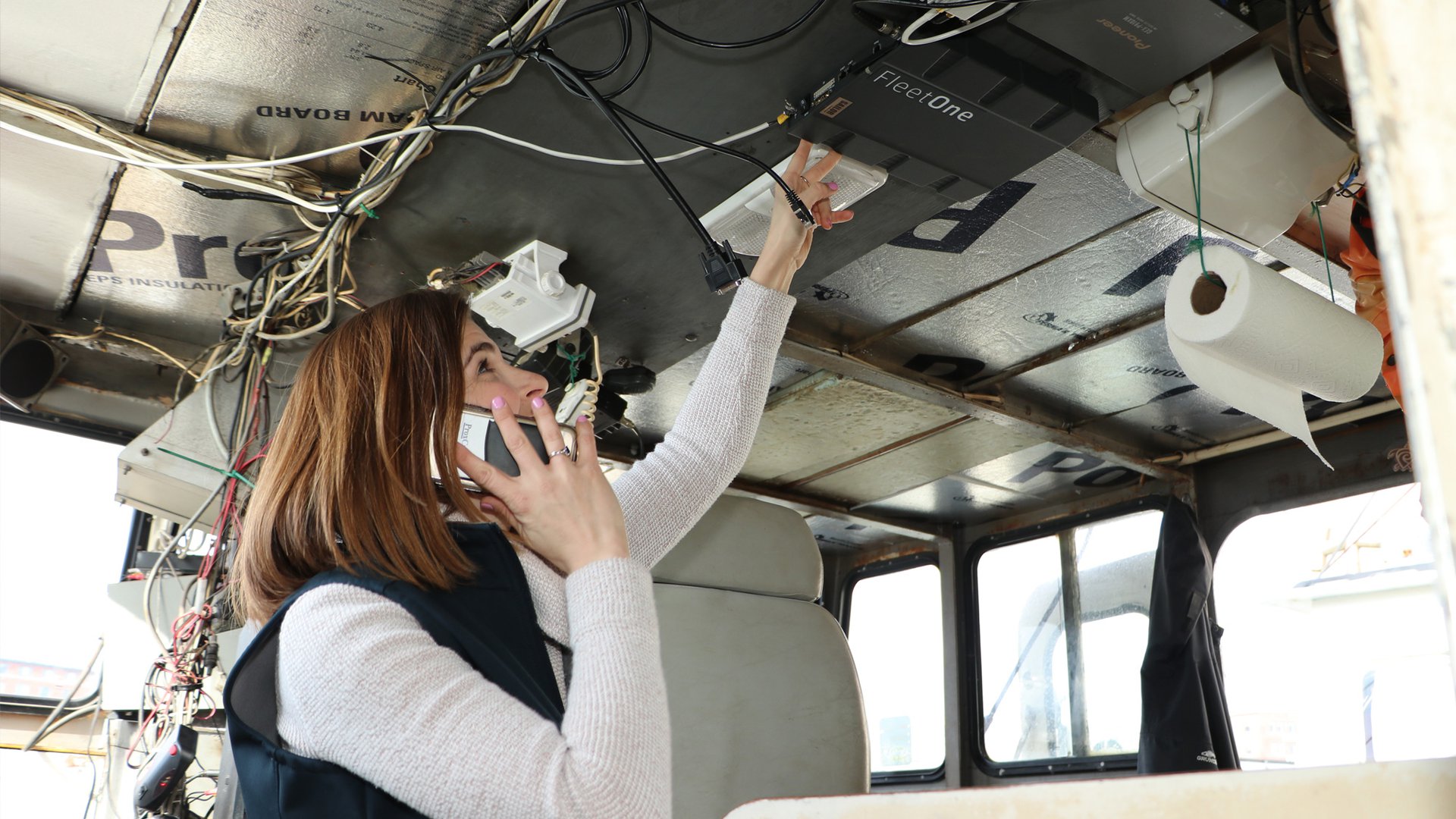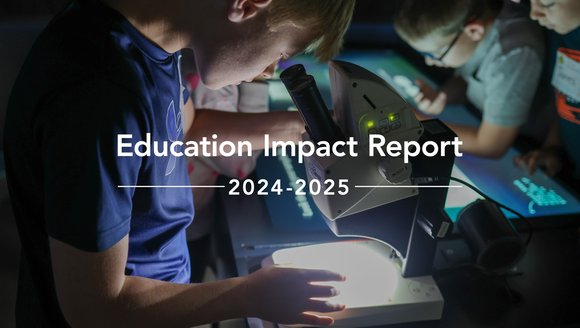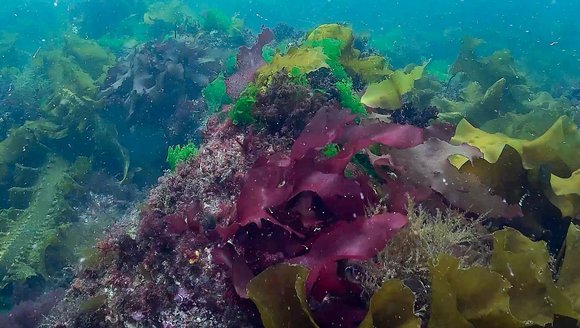Supporting Regional Fisheries
Perspectives | Dec 31, 2019
by Heather Cronin
Fisheries Technical Assistance Program Manager
Our Fisheries Technical Assistance Program (FTAP) provides a range of technical, convening and innovation services to New England’s commercial fishing industry to promote the long-term prosperity of local fisheries and fishing communities. In 2019, the program team made progress across the major initiatives conducted in support of these goals.

Electronic Monitoring
To comply with federal regulations, fishermen in the Gulf of Maine are monitored by fisheries observers — people who ride along with fishermen to collect catch data. There are several challenges associated with human observers, including safety and cost.
In recent years, the Gulf of Maine Research Institute and fishermen partners have pioneered a new technology called electronic monitoring (EM) — a system of cameras and computers mounted onboard fishing vessels.
As a result of the efforts of our program team and their partners, EM programs within the region have grown tremendously in the past year, and regional legislation, known as Amendment 23, is poised to approve EM as monitoring tool in the Northeast Groundfish fishery in the upcoming year.
The Maximized Retention EM Model
The Gulf of Maine Research Institute has spent the last two years developing the Maximized Retention EM Model. This model is targeted at high-volume, offshore vessels in the New England Multispecies Groundfish Fishery, and is designed to improve accountability and decrease monitoring costs for a subset of the groundfish fleet for whom electronic monitoring was previously inaccessible. Participating vessels are exempt from minimum size requirements for allocated groundfish species and instead must retain fish they would otherwise be required to discard (dead) at-sea. EM is used as a compliance tool to ensure all groundfish are landed and, rather than recording discards at-sea, all allocated fish are accounted for on shore by a dockside monitor. As a part of this program, GMRI is also pioneering novel technology solutions to reduce the cost, logistic and catch handling burdens of EM, improve data transmission time, and build EM system and data utility for participants in the Maximized Retention project.
In our second year of piloting the Maximized Retention program, our project team has monitored over 170 fishing trips, providing critical data to NOAA, the New England Fishery Management Council, and groundfishermen to develop program standards and a framework within which to operate an EM program for high-volume fishing vessels. Now, the program is preparing for the upcoming fishing year, in which we intend to double the program capacity and introduce new fishing operations as the next step toward implementing a Maximized Retention EM program for high volume groundfish vessels in New England. Ultimately, by successfully scaling and streamlining the program, we will prepare the Maximized Retention model, and the bodies which govern it, for implementation and adoption as a monitoring tool for the wider groundfish fleet with the approval of Amendment 23.
Thanks to our partners at Integrated Monitoring, Cvision AI LLC, The Sustainable Harvest Sector, New England Marine Monitoring, Blue Harvest Fisheries, NOAA, and participating captains and crews.
Funders include The National Fish and Wildlife Foundation and the Gordon and Betty Moore Foundation.
Implementing AI in Video Analysis
Increased participation in Electronic Monitoring programs means more video data to process. That’s why we’re working with machine learning experts to make EM programs scalable. Automation of visual imagery analysis has progressed at an amazing rate in the last decade. Many common tasks can now be fully automated, and automation is even used to enhance human performance of difficult tasks.
Instead of relying on humans to watch the video generated onboard, we’re exploring how computers could identify fishing activity directly from EM video footage. Due to the nature of the fishing operations on board the high-volume vessels in the Maximized Retention program, fishing trips are longer, vessels onboard more catch, and larger quantities of video are produced than in other EM programs. We are therefore partnering with CVision AI and Integrated Monitoring to develop machine learning algorithms which identify important activities on the decks of Maximized Retention fishing vessels. By developing such tools, we will reduce the time and cost of human video analysis.
However, the Gulf of Maine Research Institute is not alone in this initiative. Many fisheries stakeholders in New England and across the country are actively pursuing machine learning as a solution to prohibitive human review, data transmission, and storage costs of video analysis. So, on January 23, 2020 we collaborated with partners CVision AI and New England Marine Monitoring to host a workshop entitled “Incorporating Machine Learning into Northeast EM programs.” The workshop convened EM project stakeholders, AI specialists, NOAA staff, and data specialists to focus on the potential uses of machine learning in current and future programs, identify regional priorities, and discuss the pathway for incorporating AI into video analysis. Overall, 42 fisheries and EM technologies stakeholders participated in the workshop.
Together, these participants identified the following priorities for implementing AI into current and future EM protocols:
- As a region, we must clearly define what “moving forward” means, and deliberately chose which EM tasks are prioritized for automation.
- In the near term, the most promising reduction in video analysis time and cost is through developing activity recognition (AR). Developers should focus on the progression of AR and build confidence in those models.
- Clear algorithm performance standards must be defined. As a region, we should first document and define a baseline standard, and then determine “what is good enough” for algorithm performance.
- We must develop a process for submitting and approving new innovations in automatic analysis or processing of EM data.
- A clear and realistic timeline needs to be developed for implementing machine learning goals.
Our program team has also leveraged its experience designing EM programs to help others create electronic monitoring systems suited for automated or semi-automated video analysis by publishing (with our partner CVision AI) a new design manual. The manual focuses on aspects of EM programs or systems that can make or break automation capabilities. It presents a broad range of information to guide industry groups, governments, or EM vendors considering or currently developing automated EM programs, and provides technical detail for groups which have experience in automated EM programs and an interest in the lessons learned from New England.
Thanks to our partners at Integrated Monitoring and CVision AI.
Funders include The National Fish and Wildlife Foundation and the Gordon and Betty Moore Foundation.
Using EM Systems as Research Platforms
As a result of our partnership with groundfishermen in our EM programs, fishermen throughout New England are bringing forward new collaborative research ideas. One such idea was to modify an Ultra-Low-Opening Trawl (ULOT) net, previously developed by GMRI Research Scientist Steve Earys, to further reduce unintended bycatch of Atlantic Cod while fishing for flatfish species such as yellowtail flounder or grey sole.
The fisherman who proposed this idea is a participant in the Maximized Retention program and our team saw an opportunity to test the EM system onboard his vessel as a data collection platform for scientific research. While the fisherman conducts commercial trials of the modified net, we collect data on catch, fishing effort, net handling and performance, and the duration of certain fishing activities using the EM video and electronic reporting inherent to the Maximized Retention program. Normally, collecting this data would require the deployment of a research technician, additional on-board sampling, and copious note taking and reporting.
By utilizing and establishing the effectiveness of an EM system as a data-collection platform for scientific research, we hope this project will demonstrate the potential for EM systems to be used not only for fisheries monitoring, but also to advance our capacity to collect data for fisheries research.
This work is funded by NOAA’s Bycatch Reduction and Engineering Program, and includes partners at The Nature Conservancy and The Massachusetts Division of Marine Fisheries.
Reviewing the Catch Share Program
In 2010, the implementation of a catch share management program in New England’s groundfish fishery sparked dramatic changes in every aspect of the industry. This program introduced a market-based approach to the fishery, in which the total allowable catch of groundfish stocks was allocated amongst fishing cooperatives called sectors. To augment their initial allocation, sectors and their members can lease or trade allocation from other sector fishermen, ideally, building a portfolio that balances target and constraining stocks.
In 2019, the New England Fishery Management Council (Council) launched its first review of the Northeast Multispecies catch share program. As part of that process, the Council commissioned the Gulf of Maine Research Institute to conduct a series of port meetings to solicit public comment about the groundfish sector management system. These meetings provided a forum for stakeholders to share their perspectives, experiences, and on-the-water observations of changes to the fishery and to their communities since the implementation of the sector management system.
Our team hosted nine port meetings, in: Ellsworth ME, Portland ME, Portsmouth NH, Gloucester MA, Plymouth MA, Hyannis MA, New Bedford MA, Narragansett RI, and East Hampton NY, between July 18 and August 21, 2019. We heard a wide range of industry comments including the relative merits of the catch share program compared to previous management systems, challenges such as increased costs, decline of port infrastructure, and consolidation of the groundfish fleet. We also heard suggestions to promote a prosperous future in the regional groundfish industry. Our Fisheries Technical Assistance Program plans to use comments from the industry to identify and pursue future initiatives and provide increased support to our local fisheries.
We reported preliminary results in a presentation to the Council in its September meeting, and the final report will be published by the Council in April 2020. Our presentation and report may be found through the Council’s webpage.
This work was commissioned by the New England Fishery Management Council. Thanks to all those who attended and participated in public port meetings.



